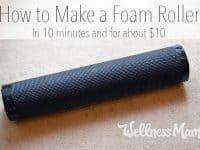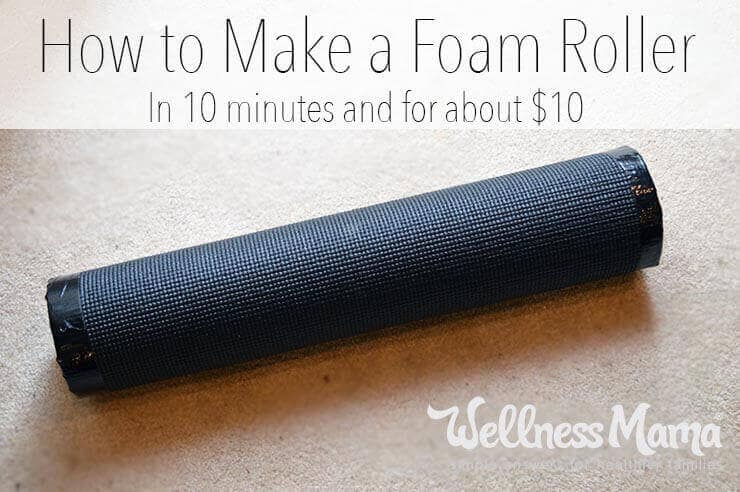

Isn’t it great that as moms, we always have the time and money to go get a massage whenever we need one? I’m kidding, of course as most of us are lucky if we can squeeze in getting a shower between throwing a meatloaf in the slow cooker and cleaning a bathroom.
In fact, between the nursing, baby carrying, house cleaning, kickball playing, cleaning, and all the other mom jobs, I’d say that moms are pretty high on the list of people who need a massage. In fact, the list probably goes something like this:
- MMA fighters
- Moms
- Football players
- Professional rock climbers
- Stunt doubles
- Everyone else…
I joke of course, but the work of a mom can be stressful and physically demanding, and often difficult to have the time/resources to get a massage (or talk an equally tired hubby into giving one).
A Simple DIY Solution…Foam Roller
Before my current pregnancy, I was doing Crossfit most days (since I’ve had placenta previa in the past and a partial abruption, it wasn’t a good idea to keep doing heavy lifting and super high intensity until we knew where the placenta is).
One thing I missed about Crossfit (besides the burpees, of course) was the makeshift foam rollers they always had. Foam rolling was often recommended after workouts and there was an assortment of various types of foam rollers including a simple all-foam one that didn’t work for me at all and several homemade rollers made of PVC pipes.
Some of these foam rollers were covered with a soft foam and others were just pieces of 4 or 6 inch PVC pipe without a cover (these were the most effective, but painful).
I love my Rumble Roller that I’ve had for years, but it tends to be slightly painful when I’m pregnant and I wanted a smoother option. Since most foam rollers can be pretty pricey, I decided to make a DIY version of the simple rollers that I’d used at Crossfit that were so effective.
Why Foam Rolling?
From my experience, because it feels amazing, especially after a good workout, and can offer some of the same muscle relaxation as massage.
According to some sources, there are some other benefits to foam rolling as well, especially for muscle fascia.
Fascia is the connective tissue that covers muscles in the body. It can become tight, which might inhibit normal range of motion and lead to muscle stiffness. Specialized massage, called myofascial release can help release this tension in the fascia and increase range of motion (I once got a myofascial massage and it was by far the most effective massage I’ve ever gotten).
One study showed that foam rolling, a type of self myofascial massage, could increase range of motion without decreasing performance. (1)
Other studies have found that foam rolling made stretching more effective and promoted proper fascia development, as fascia is continually being created by the body.
Foam rollers are often called the “poor man’s massage” as they allow people to get the daily benefits of self myofascial release at home.
How to Make a Foam Roller
As I mentioned above, I have a Rumble Roller (a type of foam roller with bumps on it that works like a deep tissue massage) but preferred the smooth and firm homemade rollers at the Crossfit gym.
I realized I could easily make a PVC foam roller at home very inexpensively, and decided to give it a shot. It ended up being a very fast process and cost less than $10 (because I already had some of the materials on hand). Here’s what I did:
Materials:
- A 2-foot length of PVC pipe (4 inch or 6 inch thickness)- I already had this, but I’ve seen prices range from a few dollars up to about $7 for a pre-cut length at home improvement stores
- Some type of foam cover- I used a yoga mat I picked up at a thrift store (similar to this one) but rubber shelf liner or a rug pad will also work for a thinner cover. It is not necessary to use a foam cover, though straight PVC pipe can be too firm and painful for some people (including me!)
- Duck tape – I already had this too
What to do:
- Cut a 24-inch length of 4 inch PVC pipe. Many home improvement stores sell short sections already pre-cut but they are often more expensive than 8 or 10 foot lengths. If you only plan to make one foam roller, it may be easier to get the pre-cut length, but most places will cut these pipes at no cost in store, especially if they are not busy. For the price of making a single foam roller, you could easily get a longer length of PVC and have it cut into several sections, use the yoga mat to cover all of them and make 3-4 foam rollers as gifts, all for less than $20.
- Roll the yoga mat or other covering out on the floor and place the pipe at one end. Roll the PVC until it is completely covered with the mat and mark this point.
- Use a sharp scissors or a utility knife to cut the mat at this place.
- Wrap the cut piece of yoga mat around the PVC and tape along this line with duck tape. Use additional tape to tape around both sides to keep the mat from sliding.
- Congrats! You just made a foam roller…
How to Use A Foam Roller
This video shows how to use a foam roller for self myofascial release and muscle relaxation, and many personal trainers and functional movement specialists may also be able to provide instruction. The same cautions would apply to foam rolling as to massage, and of course, check with a doctor or health professional before using this, especially if you have a health condition.
Other Ways to Get Self Myofascia Release
Thanks to suggestions from my brother-in-law (a functional movement trained specialist), I’ve found a variety of simple tools that can be used for self myofascial release.
Besides this simple foam roller, I’ve also used lacrosse balls or tennis balls to target specific points or to roll out the bottoms of my feet. Also, while I feel a little ridiculous using it, I recently bought a Theracane to help target tight spots in my back and I’m amazed at how well it works (and costs much less than a massage).
These simple and inexpensive tools have let me get some of the benefits of massage at home in between meatloaf making and bathroom cleaning. Not quite as relaxing as a traditional massage, but I’ll take it!
Ever used a foam roller? Gotten a myofascial massage? Did it help you?
How to Make a Foam Roller for About $10 originally written by Wellness Mama.
from Wellness Mama » Blog http://wellnessmama.com/60292/how-to-make-a-foam-roller/?utm_source=rss&utm_medium=rss&utm_campaign=how-to-make-a-foam-roller
via SEO Derby
No comments:
Post a Comment